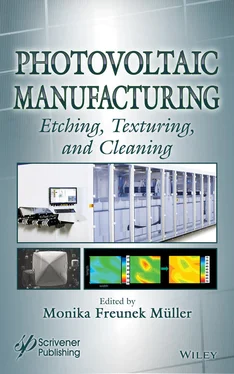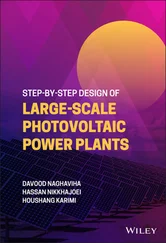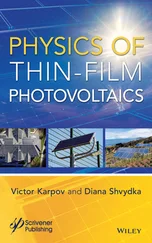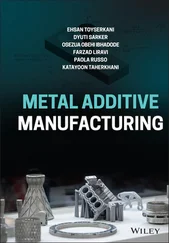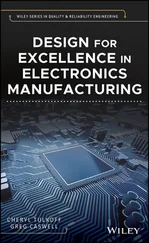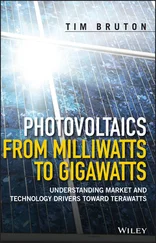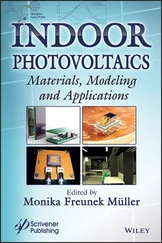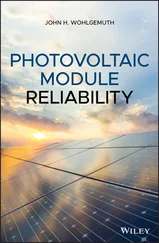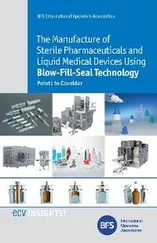1 Chapter 2Table 2.1. Micrographs of texturing for different concentrations (100%, 50%, and...Table 2.2. Requirements and advantages of the candidates to substitute IPA.
2 Chapter 4Table 4.1. Detection and quantification limits calculated according to [66] of t...Table 4.2. DOE for the cleaning of textured wafers (slurry/diamond wire sawed).
3 Chapter 5Table 5.1. Semi-quantitative results of a TD-GC-MS analysis of organic surface c...
1 Cover
2 Table of Contents
3 Title Page
4 Copyright
5 Preface
6 Begin Reading
7 Index
8 Also of Interest
9 End User License Agreement
1 v
2 ii
3 iii
4 iv
5 ix
6 x
7 xi
8 xii
9 xiii
10 1
11 2
12 3
13 4
14 5
15 6
16 7
17 8
18 9
19 10
20 11
21 12
22 13
23 14
24 15
25 16
26 17
27 18
28 19
29 20
30 21
31 22
32 23
33 24
34 25
35 26
36 27
37 28
38 29
39 30
40 31
41 32
42 33
43 34
44 35
45 36
46 37
47 38
48 39
49 40
50 41
51 43
52 44
53 45
54 46
55 47
56 48
57 49
58 50
59 51
60 52
61 53
62 54
63 55
64 56
65 57
66 58
67 59
68 60
69 61
70 62
71 63
72 64
73 65
74 66
75 67
76 68
77 69
78 70
79 71
80 72
81 73
82 74
83 75
84 76
85 77
86 78
87 79
88 80
89 81
90 83
91 84
92 85
93 86
94 87
95 88
96 89
97 90
98 91
99 92
100 93
101 94
102 95
103 96
104 97
105 98
106 99
107 100
108 101
109 102
110 103
111 104
112 105
113 106
114 107
115 108
116 109
117 110
118 111
119 112
120 113
121 115
122 116
123 117
124 118
125 119
126 120
127 121
128 122
129 123
130 124
131 125
132 126
133 127
134 128
135 129
136 130
137 131
138 132
139 133
140 134
141 135
142 136
143 137
144 138
145 139
146 140
147 141
148 142
149 143
150 144
151 145
152 146
153 147
154 148
155 149
156 150
157 151
158 152
159 153
160 154
161 155
162 156
163 157
164 158
165 159
166 160
167 161
168 162
169 163
170 164
171 165
172 166
173 167
174 168
175 169
176 170
177 171
178 172
179 173
180 174
181 175
182 176
183 177
184 178
185 179
186 180
187 181
188 182
189 183
190 185
191 186
192 187
Scrivener Publishing
100 Cummings Center, Suite 541J
Beverly, MA 01915-6106
Publishers at Scrivener
Martin Scrivener ( martin@scrivenerpublishing.com)
Phillip Carmical ( pcarmical@scrivenerpublishing.com)
Photovoltaic Manufacturing
Etching, Texturing, and Cleaning
Edited by
Monika Freunek Müller
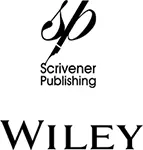
This edition first published 2021 by John Wiley & Sons, Inc., 111 River Street, Hoboken, NJ 07030, USA and Scrivener Publishing LLC, 100 Cummings Center, Suite 541J, Beverly, MA 01915, USA
© 2021 Scrivener Publishing LLC
For more information about Scrivener publications please visit www.scrivenerpublishing.com.
All rights reserved. No part of this publication may be reproduced, stored in a retrieval system, or transmitted, in any form or by any means, electronic, mechanical, photocopying, recording, or otherwise, except as permitted by law. Advice on how to obtain permission to reuse material from this title is available at http://www.wiley.com/go/permissions.
Wiley Global Headquarters
111 River Street, Hoboken, NJ 07030, USA
For details of our global editorial offices, customer services, and more information about Wiley products visit us at www.wiley.com.
Limit of Liability/Disclaimer of Warranty
While the publisher and authors have used their best efforts in preparing this work, they make no representations or warranties with respect to the accuracy or completeness of the contents of this work and specifically disclaim all warranties, including without limitation any implied warranties of merchantability or fitness for a particular purpose. No warranty may be created or extended by sales representatives, written sales materials, or promotional statements for this work. The fact that an organization, website, or product is referred to in this work as a citation and/or potential source of further information does not mean that the publisher and authors endorse the information or services the organization, website, or product may provide or recommendations it may make. This work is sold with the understanding that the publisher is not engaged in rendering professional services. The advice and strategies contained herein may not be suitable for your situation. You should consult with a specialist where appropriate. Neither the publisher nor authors shall be liable for any loss of profit or any other commercial damages, including but not limited to special, incidental, consequential, or other damages. Further, readers should be aware that websites listed in this work may have changed or disappeared between when this work was written and when it is read.
Library of Congress Cataloging-in-Publication Data
ISBN 978-1-119-24189-8
Cover image: Top figures: RENA Technologies GmbH – BatchTex machine for solar wafer texturing Bottom row left: Technological Institute of Microelectronics (TiM), University of the Basque Country (UPV/EHU), Bilbao, Spain
Bottom row right: Fraunhofer Institute for Microstructure of Materials and Systems IMWS, Research Unit Center for Silicon Photovoltaics CSP, Halle (Saale), Germany
Cover design by Russell Richardson
Set in size of 11pt and Minion Pro by Manila Typesetting Company, Makati, Philippines
Printed in the USA
10 9 8 7 6 5 4 3 2 1
The last two decades were groundbreaking for photovoltaic (PV) technology. Countless researchers, engineers, technicians, politicians, and individuals all over the world contributed with their work and enthusiasm to the progress of this field. In this time, silicon PV cells increased their efficiency to 26.1% [1], being close to their theoretical limit for real cells of 29.8% [2]. PV technologies such as multijunction solar cells achieved a maximum of 39.2% efficiency in nonconcentrated applications [1], and new emerging technologies such as perovskites evolved. Figures 1and 2visualize the impressive progress in photovoltaics, depicting the best research cell efficiencies ( Figure 1) and the champion module efficiencies ( Figure 2). Both figures start with a few technologies, remarkable achievements, and, especially in the case of modules, a somewhat steady progress. The first cell type ever recorded in these data, an a:Si:H cell, evolved from 2.4% efficiency in 1976 to 14.1%. However, shortly around the year 2000, 10 new photovoltaic technologies evolved, increasing the record PV efficiency from 31.9% in 2000 by more than 50% to 47.1%. Not only were 40% of the technologies of today developed during the last two decades but also their efficiency trends are improving much steeper than ever before in the PV history.
Читать дальше
